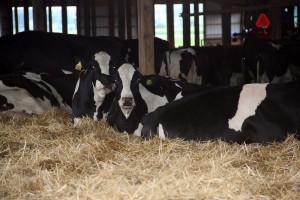STERLING, Ohio — Family and farming are the backbone of Sterling Heights Dairy, host for this year’s Dairy Twilight Tour, held July 14.
The annual event is organized by the Wayne-Ashland Dairy Service Unit, and showcases the dairy industry to farmers and the public.
The farm, located in Sterling, Ohio, in northern Wayne County, is owned and operated by Jim and Anne Saal, along with their sons Matt and Mark, daughters Jenny and Sarah and their families.
History
The farm was established in 1957 when Jim’s parents, Ernest and Edith Saal, purchased the 80-acre home farm. Jim and Anne took over the farming operation when Ernest retired.

After Mark and Matt indicated that they were interested in returning to the farm following college, Saals began expanding the operation to 250 cows and formed a Limited Liability Corporation.
The farm name, Sterling Heights Dairy, according to Matt, is a nod towards the neighboring town of Sterling, a small Wayne County community. Jim added that although he was satisfied milking a smaller herd, he was glad his family was interested in the farming operation.
“If they hadn’t been interested, I don’t think we would have expanded the dairy operation,” he said.
Today, they farm 800 acres and milk 500 head of Holsteins and Holstein crossbreds, three times a day.
By the numbers
Daily milk production per cow averages in the mid-80s with a fat test of 3.65 and a 3.05 protein test. They maintain a somatic cell count of 170,000. Cows are milked in a double-12, rapid-exit parlor and fed a mix of haylege, commodities and supplement.
“There is nothing fancy, nothing special about our farm,” Matt said. “We just work hard every day.”
The Saals maintain a closed herd, choosing to build the herd from within. The herd is predominately Holstein, with a few Holstein-Jersey crosses mixed in. They have approximately 500 head of replacement heifers. Matt said the Jersey genetics has helped improve their components, and ultimately, the premium they receive from Dairymen’s Milk Co., where their milk is processed.
Group strategy
The cows are grouped according to their stage in lactation. Dry cows and heifers are housed in one barn, and the milking herd and fresh cows are housed in other barns.
First-lactation animals are in one group, and second-lactation and higher are in a second group. They also have a post-freshening group, which they keep separate, and a maintenance group of pregnant and end of lactation animals.
The dry cow and heifer barn was designed by Mark. The new barn was completed in 2012 and features side curtains and fans to improve air movement in the facility. The barn features a bedded pack for the dry cows, and Saals use a just-in-time philosophy to move cows into the maternity pen at calving time.
Calving
Calves are moved to another barn at one to two days of age and have had adequate colostrum before being switched to pasteurized whole milk. They are housed in individual pens until they are 2 to 3 months of age and moved to a group pen.
Heifers are housed in group pens in the barn. When heifers are moved into the barn at 3 months of age, they are in a group pen. From there, move to the pre-breeding and breeding age group. Once the heifers are bred, they are moved into the third pen in the barn. The barn has sand-bedded free stalls with head locks in the pens for the older heifers. This gets the heifer used to the free stalls and headlocks they will be using once they hit the milking string.
Future plans
Matt said when it comes to making decisions, they discuss it as a family, but Jim and Anne have the final say. They are working on a transition plan to pass the farm to the next generation.
Future plans include another expansion of the dairy herd and acquiring more land to grow feed and handle manure from the operation. In addition to family members, Saals have nine additional employees.
Like family
Matt said working with non-family members has been a learning process.
“We are trying to be better employers,” he said. “We have found that the key is to hire good employees and get out of their way. We have good employees who are good workers and want to do well. They do a good job and know the program. People want to work here.”
Dan Ellington has been at the farm since 2007.
“Saals treat their employees like family,” Ellington said.
David Acker had worked with Matt before. When the opportunity came to join the crew at Sterling Heights Dairy, he jumped at it.
“It made my day when Matt told me I had a full-time job on their farm,” Acker said.
Way of life
Growing up on a farm was a wonderful way of life for their children, Anne said. They had the opportunity to participate in 4-H and FFA. They also exhibited animals at the fair. Anne admitted that although farming can be a challenge — particularly with the weather and up-and-down milk prices — they work through it.
“Everything has challenges,” she said.
The family takes every opportunity they can to open their farm to church groups, school students and farm tours, Jenny said. She said the tours give them a chance to share their story about agriculture and what they do on their farm with people in the community.
This year, 89 businesses provided support to the Wayne-Ashland Dairy Service unit to help put on the tour.











